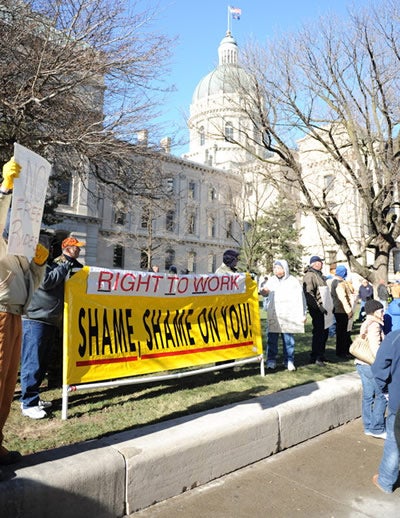Uncategorized
Right to Work Still Wrong for Workers

An anti-worker law by any other name is still an anti-worker law.
While the decades-long decline in real wages for American workers continues to track with falling unionization rates, corporate interests remain determined to wage state-level assaults on the middle class. So-called “right-to-work” laws are still the weapon of choice for anti-worker lawmakers and their big business allies.
Better understood as “No rights at work” or “right to work for less,” the misnamed right-to-work laws strip workers of their rights by crippling the unions that protect and enforce them.
These laws prohibit labor agreements that require all workers to share in the cost of collective bargaining, thereby undermining collective bargaining itself.
Right to work weakens representation by allowing some workers to enjoy the advantages of union membership without contributing to the benefits. It eliminates job security, lowers pay and forces full-time workers into part-time jobs. In short, it’s a tool to roll back rights and put more money into the swollen pockets of the rich.
Corporate America has been pushing right-to-work laws with a vengeance in recent years, determined to see how low they can drive down American labor costs. Tea party governors have been more than happy to facilitate this effort. Wall Street and the billionaire Koch brothers have been financing the war on workers through the American Legislative Exchange Council (ALEC), a group that has spearheaded the passage of right to work and other anti-worker laws in state legislatures.
In a time when workers are being pushed out of the middle class and corporate profits are soaring, right to work has compounded the rise in income inequality. That’s precisely the goal of groups like ALEC. While tens of thousands of union members and supporters turned out in the streets to oppose right to work last year, the paid hit men of the business elite, masquerading as state legislators, rammed though right to work in two more states. Michigan has become the 26th right-to-work state, striking a major blow against workers in the birthplace of the modern labor movement.
Ohio is the next battleground for workers’ rights. There is now a bill, HB 151, and a ballot proposal threatening to add Ohio to the list of right-to-work states. Working families came together to successfully defeat other anti-union legislation in Ohio two years ago. A similar struggle will be necessary to stop it again.
Teamsters and all workers need to get involved and stay informed. Visit the Teamster Nation blog at www.teamsternation.blogspot.com and www.teamster.org or news on right-to-work battles and how you can get involved.
“The more the other side wins, the harder they will push to win more. But the harder we push back, the stronger we become as Teamsters and as a labor movement,” said Jim Hoffa, Teamsters General President.